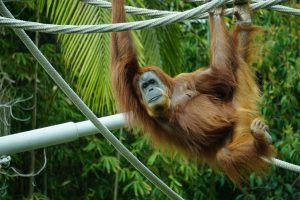Wildlife charities understand that animals are victims of climate change. Oftentimes, habitats are destroyed by increasing temperatures or climatic shocks. Now more than ever, there is a need to mitigate the impact of climate change.

- It has become quite apparent that wildlife and climate change are somehow connected.
- Conservation measures and going green can help tackle the problem of climate change.
Wildlife’s Role in Mitigating Climate Change
Here’s a brief on how wildlife plays a vital role in mitigating climate change through three key mechanisms:
-
Carbon Sequestration
Wildlife maintains and sequesters carbon dioxide gas from our atmosphere. Also, monkeys and other bird species, help in forestation by dispersal of seeds. Phytoplanktons take in large quantities of carbon from the ocean and thanks to waste from whales, these tiny creatures can boom in large numbers.
-
Ecosystem Engineers
Species such as beavers and elephants bring changes that favour the surroundings. Beavers build wetlands, which lock carbon. Elephants help in planting additional trees through seed dispersal, thus, helping in the locking of carbon.
-
Nutrient Cycling
Also, wildlife maintains the health of an ecosystem through the cycling of nutrients. An amazing example of this occurs when decomposers decompose dead organic matter. This, in turn, is utilised by plants for growth and food production, also entailing the storage of carbon. The availability of this nutrient-rich decaying matter is possible through the death of species.
Effects of Climate Change on Wildlife
Climate change poses significant threats to wildlife, including:
-
Habitat Disruption
Global warming changes ecosystems and makes living environments unbearable due to its effects. Polar bears lose sea ice, and coastal species are endangered due to the increase in sea levels.
-
Food Chain Disruptions
Climate change causes shifts in food ecosystems creating changes in prey abundance. This affects predators greatly and even causes unusual migration patterns.
-
Extinction Risk
Population decrease as a result of climate change poses an increased risk to many species. These declines are often influenced by restricted habitats as well as food shortages.
Conservation Strategies for Climate Change
Here are some common wildlife conservation strategies for climate change:
Preserve and Restore Natural Habitats
Preserve and expand natural spaces through:
- Afforestation and reforestation
- Marine protected areas
- Ecosystem restoration
Climate-Smart Conservation
Adapt conservation efforts for climate change through:
- Enhancing ecosystem resilience
- Assisted species migration
Minimise Human-Wildlife Conflict
Implement sustainable community activities to:
- Reduce resource competition
- Decrease human-wildlife conflict
- Conserve species habitats
Conclusion
It has become quite apparent that wildlife and climate change are somehow connected. Many people do not appreciate that wildlife and wildlife charities have a great significance in combating climate change. Nevertheless, wildlife is categorised amongst those most critically affected by climate change, thereby significantly affecting species survivability and the supported biomes. As said before, conservation measures and going green can help tackle the problem of climate change.
We would love to hear your questions and thoughts concerning this article at the bottom of this post.


